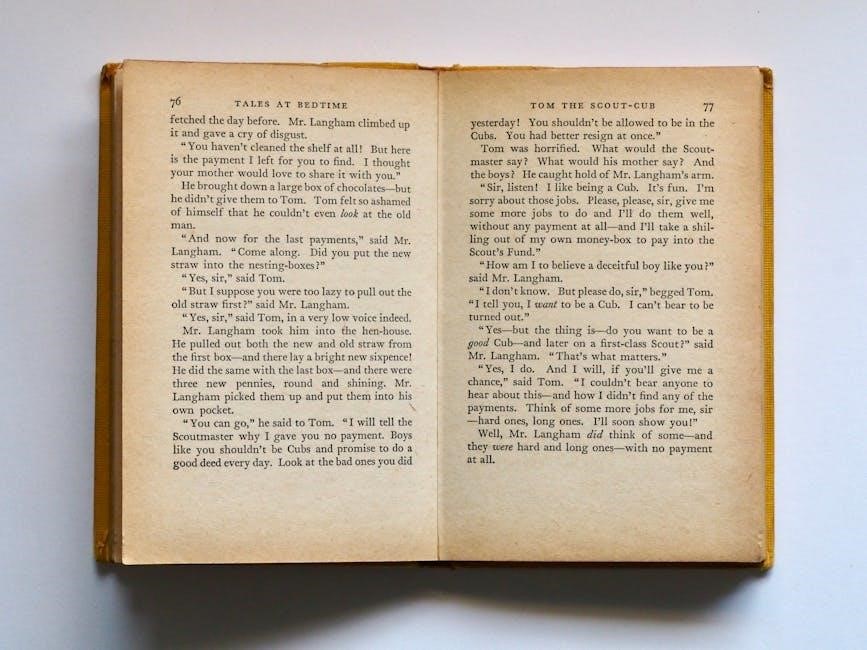Nathaniel Hawthorne’s “The Birthmark” is a thought-provoking story published in 1843, exploring themes of perfection and human imperfection through a scientist’s obsession with his wife’s birthmark․
1․1 Overview of the Story
Nathaniel Hawthorne’s “The Birthmark” revolves around Aylmer, a brilliant scientist, and his wife Georgiana, who bears a distinctive birthmark on her cheek․ Aylmer becomes obsessed with the mark, viewing it as a flaw in an otherwise perfect creation․ His fixation leads him to attempt its removal, driven by his belief that perfection is attainable through science․ Georgiana, while loving and supportive, struggles with her own insecurities about the mark․ The story explores themes of perfection, the dangers of unchecked scientific ambition, and the human condition․ Ultimately, Aylmer’s pursuit of flawlessness results in tragic consequences, raising profound moral questions about the limits of science and the value of human imperfection․
1;2 Availability in PDF Format
Nathaniel Hawthorne’s “The Birthmark” is widely available in PDF format, making it easily accessible for readers worldwide․ Platforms like Project Gutenberg and Internet Archive offer free downloads of the story, ensuring its accessibility to the public․ Additionally, educational websites and digital libraries provide the PDF version, often accompanied by study guides and annotations․ This convenient format allows readers to explore the themes of perfection, science, and human imperfection in a portable and readable way․ The PDF version is ideal for academic purposes, personal reading, or classroom discussions, ensuring the timeless tale remains relevant and accessible to modern audiences․

About Nathaniel Hawthorne
Nathaniel Hawthorne, born on July 4, 1804, in Salem, Massachusetts, was a renowned American author known for his rich, symbolic storytelling and exploration of human nature․
2․1 Background and Significance

Nathaniel Hawthorne, born on July 4, 1804, in Salem, Massachusetts, was a prominent American novelist and short story writer․ His birthplace is now a museum, reflecting his historical significance․ Hawthorne descended from a notable family, including William Hathorne, who emigrated from England in 1630 and later persecuted Quakers, and John Hathorne, a judge involved in the Salem witch trials․ These ancestral ties deeply influenced his writing, often exploring themes of guilt, redemption, and the human condition․ Hawthorne’s works, such as The Scarlet Letter and The House of the Seven Gables, are celebrated for their Gothic themes and psychological depth․ His writing career flourished in the 19th century, earning him a reputation as one of America’s most important literary figures․ His stories often examine moral and ethical dilemmas, making his work timeless and thought-provoking․

Plot Summary
Nathaniel Hawthorne’s The Birthmark (1843) tells the story of scientist Aylmer’s obsession with removing his wife Georgiana’s birthmark, exploring themes of perfection, science, and tragic human imperfection․
3․1 Setting
The story of The Birthmark is set in the latter part of the 18th century, a time when scientific inquiry and experimentation were gaining prominence․ The primary setting is the home and laboratory of the scientist, Aylmer, where most of the narrative unfolds․ The laboratory, filled with scientific equipment and experiments, symbolizes Aylmer’s intellectual and obsessive pursuits․ In contrast, the domestic space represents the personal and emotional realm of his wife, Georgiana․ The interplay between these two settings highlights the tension between scientific ambition and human emotions․ The time period and setting are crucial in establishing the story’s themes of perfection, mortality, and the ethical implications of scientific progress․ The detailed description of the laboratory and the birthmark itself creates a haunting and introspective atmosphere․
3․2 Main Characters
The story revolves around Aylmer, a brilliant yet obsessive scientist, who is consumed by his quest for perfection․ His wife, Georgiana, is a kind and beautiful woman bearing a distinctive birthmark on her cheek, which Aylmer sees as a flaw․ The birthmark becomes the central focus of Aylmer’s obsession, symbolizing human imperfection․ Another key character is Aminadab, Aylmer’s rough and practical assistant, who represents a grounding force amidst Aylmer’s intellectual pursuits․ These characters drive the narrative, exploring themes of perfection, mortality, and the consequences of scientific hubris․ Their interactions reveal the emotional and philosophical tensions at the heart of the story․
3․3 Key Events

The story begins with the marriage of Aylmer, a scientist, and Georgiana, a woman with a distinctive birthmark on her cheek․ Aylmer becomes obsessed with the birthmark, seeing it as a symbol of human imperfection․ He convinces Georgiana to undergo an experiment to remove it, despite her initial reluctance․ Aylmer prepares a potion and administers it to Georgiana, but the experiment ultimately fails․ The birthmark disappears, but Georgiana dies shortly after, symbolizing the tragic consequences of Aylmer’s pursuit of perfection․ These events highlight the central conflict between scientific ambition and human limitations, driving the story’s exploration of themes such as imperfection, mortality, and the dangers of unchecked scientific hubris․
Themes in “The Birthmark”
The story explores themes of perfection, science’s ethical limits, and the human condition, highlighting the dangers of obsessive pursuits and the inevitability of imperfection and mortality․
4․1 Pursuit of Perfection
Nathaniel Hawthorne’s “The Birthmark” delves into the theme of the pursuit of perfection through Aylmer’s obsessive attempt to remove his wife’s birthmark․ Aylmer, a scientist, views the mark as a flaw in Georgiana’s otherwise perfect beauty, symbolizing human imperfection․ His fixation on eradicating it reflects a broader societal desire for an unattainable ideal, driven by scientific hubris and a belief in human control over nature․
Aylmer’s experiments, despite their risks, are justified in his mind by the potential to achieve perfection․ The story critiques this relentless pursuit, as it ultimately leads to tragic consequences․ Hawthorne uses the birthmark as a metaphor for the inevitability of imperfection, questioning whether perfection is even desirable or attainable․
4․2 Role of Science
Nathaniel Hawthorne’s “The Birthmark” critically examines the role of science through Aylmer’s obsessive experiments․ Aylmer, a skilled scientist, represents the potential of scientific progress but also its dangers when driven by hubris․ His belief in the power of science to achieve perfection leads him to attempt the removal of Georgiana’s birthmark, showcasing science as both a tool for advancement and a force of destruction․ The story highlights the ethical dilemmas of scientific pursuits, questioning the limits of human knowledge and the consequences of tampering with nature․ Hawthorne portrays science as a double-edged sword, capable of remarkable achievements but also prone to misuse when unchecked by moral or emotional considerations․
4․3 Human Condition
Nathaniel Hawthorne’s “The Birthmark” delves into the complexities of the human condition, exploring themes of imperfection, mortality, and the pursuit of an unattainable ideal․ The story portrays Georgiana’s birthmark as a symbol of humanity’s inherent flaws, while Aylmer’s obsession with removing it reflects the futility of trying to transcend human limitations․ Through Aylmer’s tragic failure, Hawthorne critiques the idea that science or human effort can erase the natural imperfections that define us․ The narrative also highlights the emotional and psychological toll of such pursuits, as Georgiana’s identity and self-worth are tied to the very mark Aylmer seeks to eliminate․ Ultimately, the story serves as a poignant reminder of the inevitability of human frailty and the dangers of idealizing perfection․
Character Analysis
Aylmer, a brilliant scientist, is driven by an obsession with perfection, while Georgiana, his wife, embodies humanity’s inherent imperfection through her birthmark․ Their relationship explores flawed ambition and sacrifice․
5․1 Aylmer
Aylmer, a brilliant yet obsessive scientist, is the central character of “The Birthmark․” His fixation on removing his wife Georgiana’s birthmark stems from his belief in human perfection․ Aylmer’s character highlights the dangers of unchecked scientific ambition and the pursuit of an unattainable ideal․ His actions reveal a complex mix of love, possessiveness, and arrogance․ Despite his intellectual prowess, Aylmer’s inability to accept imperfection leads to tragic consequences․ His relentless experiments symbolize the clash between science and nature, as well as the moral limits of human intervention․ Aylmer’s story serves as a cautionary tale about the ethical boundaries of scientific progress and the devastating cost of obsession․
5․2 Georgiana
Georgiana, Aylmer’s wife, is a central figure in “The Birthmark,” embodying grace, beauty, and the natural human condition․ Her distinctive birthmark, a small crimson mark on her cheek, symbolizes her uniqueness and humanity․ Georgiana is depicted as kind, gentle, and deeply devoted to her husband, yet she struggles with the idea of being imperfect in Aylmer’s eyes․ Her character represents the inherent flaws that make us human, contrasting with Aylmer’s pursuit of perfection․ Despite her initial confidence, Georgiana becomes emotionally vulnerable as Aylmer’s obsession grows, highlighting the psychological toll of being viewed as flawed․ Ultimately, her tragic fate serves as a poignant critique of the dangers of valuing perfection over human imperfection and the moral consequences of scientific hubris․ Georgiana’s story underscores the beauty of natural imperfection and the importance of self-acceptance․
5․3 Aminadab
Aminadab, the rough and uneducated laboratory assistant, serves as a stark contrast to Aylmer’s refined and intellectual nature․ His practical mindset and skeptical outlook on Aylmer’s experiments highlight the tension between science and reality․ Aminadab’s coarse demeanor and lack of sophistication make him immune to Aylmer’s obsessive pursuit of perfection, allowing him to see the folly in his master’s endeavors․ His character represents a grounding force, questioning the morality and feasibility of Aylmer’s actions․ Aminadab’s blunt reactions, particularly his horrified response to Georgiana’s death, underscore the devastating consequences of unchecked scientific ambition․ Through his character, Hawthorne critiques the dangers of prioritizing science over human ethics and emotions, making Aminadab a pivotal figure in the story’s moral commentary․
Historical Context
Nathaniel Hawthorne’s “The Birthmark” is set against the backdrop of 19th-century America, a time of burgeoning scientific exploration and philosophical debate․ The story reflects the era’s fascination with natural philosophy and the emerging field of science, which often clashed with traditional beliefs and ethical concerns․ Hawthorne, influenced by the Transcendentalist movement, explores the tension between human aspirations for perfection and the limitations imposed by nature․ The historical context also reveals societal anxieties about the rapid progress of science and its potential to disrupt moral and ethical boundaries․ By situating the narrative in this period, Hawthorne critiques the overreach of scientific ambition and underscores the enduring human struggle between reason and emotion․

Symbolism in the Story
The birthmark on Georgiana’s cheek serves as the central symbol, representing natural imperfection and human mortality․ Hawthorne uses it to explore the futility of seeking perfection, as Aylmer’s obsession with removing it symbolizes the clash between science and nature․ The laboratory, filled with scientific tools, symbolizes the pursuit of knowledge and control, while the elixir Aylmer creates represents the dangerous pursuit of perfection․ Georgiana herself symbolizes innocence and the natural world, contrasting with Aylmer’s scientific ambition․ The birthmark’s disappearance and Georgiana’s subsequent death symbolize the tragic consequences of attempting to defy nature and achieve flawlessness․ Through these symbols, Hawthorne critiques the hubris of scientific progress and underscores the inevitability of human imperfection․

Moral and Ethical Questions
Nathaniel Hawthorne’s “The Birthmark” raises profound moral and ethical questions about the limits of science, the value of human life, and the consequences of unchecked ambition․ Aylmer’s obsession with removing the birthmark challenges the ethical boundaries of scientific experimentation, particularly on a human subject․ The story questions whether the pursuit of perfection justifies risking a life, highlighting the moral dilemma of valuing physical flawlessness over human well-being․ Additionally, it explores the ethical implications of manipulating nature, as Aylmer’s actions symbolize humanity’s attempt to play God․ The tragic outcome underscores the importance of humility and the acceptance of natural imperfections, serving as a cautionary tale about the dangers of prioritizing science over humanity and the moral responsibility that comes with knowledge and power․

Reception and Impact
Nathaniel Hawthorne’s “The Birthmark” has been widely acclaimed for its profound exploration of human nature, science, and morality․ Since its publication in 1843, the story has been recognized as one of Hawthorne’s masterpieces, celebrated for its rich symbolism and philosophical depth․ It has been included in numerous anthologies and remains a staple in American literature studies․ The story’s themes of perfection, imperfection, and the dangers of unchecked ambition continue to resonate with readers, making it a timeless classic․ Its availability in PDF format has further expanded its reach, allowing modern audiences to engage with Hawthorne’s work effortlessly․ The story’s influence extends to discussions on ethics in science and the arts, solidifying its place as a foundational text in Gothic and philosophical literature․

The PDF Version
The PDF version of “The Birthmark” is widely available for free download from platforms like Project Gutenberg, offering a convenient and readable format for modern readers․

10․1 Sources for Download
Multiple reliable sources offer “The Birthmark” in PDF format․ Project Gutenberg provides a free download of Nathaniel Hawthorne’s works, including this story․ Additionally, archive․org hosts a scanned version, while the Philaletheians website offers a downloadable PDF specifically for “The Birthmark․” These sources ensure easy access to the story for readers worldwide․ All versions are free and suitable for educational purposes, making them ideal for students and enthusiasts of classic literature․
- Project Gutenberg
- Internet Archive
- Philaletheians
These platforms guarantee a seamless reading experience for fans of Hawthorne’s work․
10․2 Features of the PDF
The PDF version of “The Birthmark” offers a seamless reading experience with well-formatted text and clear typography․ Many versions include introductory notes, historical context, and study guides, enhancing understanding․ The PDFs are free to download and accessible across various devices, including e-readers and smartphones․ Some editions feature annotations and critical commentary, while others preserve the original publication’s formatting․ Platforms like Project Gutenberg and Archive․org ensure high-quality scans, maintaining the story’s authenticity․ Additionally, the PDFs are often lightweight, making them easy to share and store․ These features make the PDF an ideal choice for both casual readers and academic purposes, ensuring that Hawthorne’s timeless tale remains accessible and engaging for modern audiences․
Study Guides and Resources
Free online study guides and resources for “The Birthmark” provide in-depth analysis, character insights, and thematic discussions, aiding students and readers in understanding Hawthorne’s work․
11․1 Analysis Aids
Analysis aids for “The Birthmark” include detailed study guides, character maps, and thematic breakdowns; These resources help readers interpret the story’s deeper meanings and symbolism․
Online platforms like Project Gutenberg offer free access to PDF versions of the story, accompanied by analysis tools such as summaries and critical essays․ These aids provide insights into Hawthorne’s exploration of perfection and human imperfection․
Additionally, study guides often include discussion questions, historical context, and explanations of key motifs, making them invaluable for students and educators․ These resources enhance understanding of the story’s moral and ethical dilemmas․
By utilizing these analysis aids, readers can gain a richer comprehension of Hawthorne’s themes and the psychological depth of his characters, particularly Aylmer and Georgiana․
11․2 Additional Resources
Additional resources for studying “The Birthmark” include literary websites, educational forums, and multimedia presentations․ These tools offer supplementary insights into Hawthorne’s work․
Platforms like Project Gutenberg and Archive․org provide free access to the story in PDF format, making it easily accessible for readers worldwide․ These sites often include related works by Hawthorne, such as Mosses from an Old Manse․
Furthermore, online libraries and academic databases offer critical essays, analysis, and study guides․ These resources are particularly useful for students and researchers seeking a deeper understanding of the story’s themes and historical context․
Lastly, multimedia resources, such as audio versions and video analyses, cater to diverse learning preferences, enhancing the study experience for modern audiences․
Nathaniel Hawthorne’s “The Birthmark” remains a timeless exploration of human imperfection, scientific hubris, and the pursuit of perfection․ The story’s tragic conclusion underscores the futility of attempting to defy nature, leaving readers to reflect on the ethical implications of scientific ambition․ Its enduring relevance lies in its ability to provoke thought about the human condition and the consequences of unchecked obsession․ For those seeking to explore this classic tale, the PDF version is widely available for free download through platforms like Project Gutenberg and Archive․org, ensuring accessibility for readers worldwide․ This convenient format allows modern audiences to engage with Hawthorne’s profound narrative, making “The Birthmark” a lasting piece of American literary heritage․

